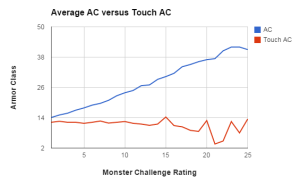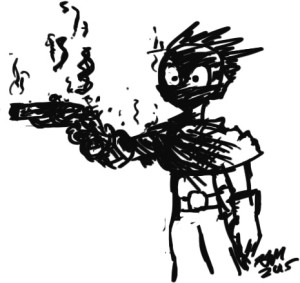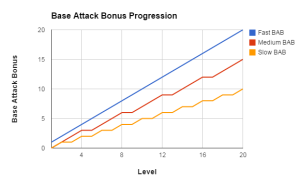A while back, I wrote this article about a Pathfinder RPG game mechanic for Mikko Kallio, RPG Superstar finalist and author of several Pathfinder titles. I welcome you to check out his blog at A Sword For Hire.
Guns in D&D seem to divide community opinions. The introduction of firearms to Pathfinder came with no exception. Debates over realism, aesthetics, and mechanics of firearms continue to appear on various forums. However, I did not come to talk about whether firearms belong in fantasy game or whether their portrayals are realistic.
Today, I will approach firearms from a game design perspective, illustrating the design issues of firearms in Pathfinder and how I designed house rules in response to a negative experience one of my players had with them.
What are Firearms in Pathfinder?
Introduced in Ultimate Combat, Pathfinder models firearms as ranged weapons that can completely bypass armor in close range. Firearms perform ranged touch attacks against foes within the first ranged increment, bypassing armor, shield, and natural armor bonuses.
Firearms possess many considerable drawbacks to balance this powerful unique ability. They tend to have a short range, high market price, obscenely expensive ammunition, and considerable feat tax to utilize. Firearms also possess a fumble mechanic where rolling a natural 1 or 2 (sometimes higher depending on the circumstances) will result in a misfire, breaking the gun or potentially exploding it. The gunslinger class was built specifically to offset many of these drawbacks. Barring an archetype, no other class can feasibly wield them.
My Experiences
You can find many GMs on Paizo’s forums telling horror stories of a gunslinger easily killing a dragon in a single round. From my experience, I’ve found the opposite true as well—firearms can be unfun for players.
My friend Jeff loves writing about fantastical worlds and characters. Intrigued that Pathfinder possessed firearm rules, he choose to recreate his gunslinging character when I invited him to my campaign.
However, Jeff found firearms absolutely frustrating to play. Misfires easily made him feel useless. The expense of ammunition weighed heavily on him. Additionally, he couldn’t use any of the gunslinger’s class features because they require grit points, which Jeff needed to save to fix misfires. If he misfired when out of grit points, Jeff was out of the fight.
The martial/spellcaster disparity also played a role in his frustration. Other PCs had many powerful spells and abilities that automatically got better with level. Jeff felt like his only class feature was being able to use a weapon that can literally explode in his face. Overall, Jeff wanted to play an awesome gun fighter, but ended up with a class that made him feel miserable.
After a year of playing his character, Jeff related his frustration to me and pleaded for some kind of fix. As a result, I took it upon myself to examine the design of firearms in Pathfinder and search for a possible house rule to make them more enjoyable for players and GMs alike. I started by looking at firearms’ distinguishing feature: touch attacks.
The Problem with Touch Attacks
The core problem of firearms lie with touch attacks, a broken game mechanic.
The issue with touch attacks stems back to the design of Base Attack Bonus (BAB) in 3rd Edition. In 3rd Edition and Pathfinder, each class level increases the character’s base attack bonus by +1, +3/4, or +1/2 with the total rounded down. Although making the math of multiclassing easier, this causes differences among BAB progressions to increase with level. This polarizes classes significantly at higher levels where fast BAB classes can never miss and slow BAB classes can never hit.
Since 3rd Edition added more spells that require an attack roll (type of spell I find pretty cool), wizards needed a way to hit targets at higher levels. Thus, 3rd Edition introduced touch attacks. However, the math around touch attacks falls apart since the average enemy touch AC decreases as monster challenge ratings increase. Some CR 20 monsters have a touch AC of zero. Barring a natural 1, a touch attack is almost guaranteed to hit.[1]

As monsters get tougher, their defense against touch attacks decrease (instead of increase like normal defenses).
In essence, the firearms rules took a broken mechanic designed to help wizards bypass high ACs and gave it to a ranged fighting class that already will excel at hitting highly armored targets.
Other Design Concerns
In order to offset the problematic mechanic of touch attacks, Ultimate Combat had to include significant drawbacks to firearms that ultimately make firearms unfun to use and build characters for.
The misfire mechanic proves particularly obnoxious. Critical failure rules are not a new concept. However, Pathfinder community generally agrees such a mechanic does little more than serve as a punch in the face for the fighter, a class that relies on iterative attacks. Gunslingers are no exception. Misfires are supposed to make firearms into a risk-versus-reward type of weapon. However, a firearm wielder has no way to opt out. Additionally, the misfire mechanic proves binary at best. Depending on the luck of the dice, a gun wielder is either useless or an armor-shredding killing machine.
The firearms rules resulted in a weapon frustrating for both GMs and players.
House Rules
As a result of my analysis, I created a set of house rules in order to fix the mechanical problems and make firearms more fun. In addition to cleaning up the firearm listings[2], I implemented the following changes.
- No more touch attacks. This is necessary to buff firearms and eliminate the drawbacks that make them annoying.[3]
- No more misfires. A firearm can only misfire if broken or loaded by a non-proficient character.
- Firearms add Dexterity modifier to damage rolls. In Pathfinder, no ranged weapon feels worth using unless you can add an ability modifier to damage rolls. Only a gunslinger had this privilege, something I decided to change. Having Dex-to-damage as an innate feature justifies the expense of firearms and makes them more accessible for non-gunslingers. I wanted to reinforce firearms having a niche as high-powered, low-range weapons.
- Gunslinger reworked. I replaced some gunslinger deeds to compensate for a less valuable gun training. I also gave gunslingers the unique ability to target touch at the cost of a grit point.
- Archetypes reworked. The infamous Musket Master archetype[4] can no longer reload as a free action. Instead, Musket Master gets Vital Strike feats as deeds, giving two-handed firearms the niche of high-damage, single-shot weapons.
My player, Jeff, became much more invested in my campaign after I implemented these house rules. His character had the power one expects from a ranged specialist, but he was no longer shredding high armored enemies and no longer had the frustration of misfires. He enjoyed them so much that he decided to include them in his own campaign, prompting many of his players to try them since they looked fun.
That was my ultimate goal: make firearms more fun for both players and GMs.
Conclusion
I believe any designer can learn from firearms in Pathfinder. The ability to execute a risky design shows the mark of a great designer. In many cases, a designer may have to use a powerful mechanic, perhaps one with inherent design flaws, and compensate with limitations or drawbacks to make it work. However, a designer should always ask themselves whether the overall package will deliver a fun experience for player and GM alike. For some particularly problematic mechanics, that might not be feasible.
I see this was the case for firearms and touch attacks. While many found joy in Pathfinder firearms, they came with mechanical issues that made playing and GMing for gunslingers frustrating and not fun. In the end, making things fun is what matters.
Footnotes
[1] Credit to Kybryn at the Paizo forums and ShoelessInsight at Gmail for providing average statistics of NPCs and monsters necessary for the charts in this article.
[2] Some of the firearm descriptions had consistency issues. In particular, the double-barreled pistol and double-barreled musket had slightly different rules text that raised many questions. I decided to follow Technology Guide’s precedent and encapsulate similar features as special qualities.
[3] I’ve seen suggestions on giving firearms penetration ratings or some similar mechanic. Such ideas do not appeal to me because they complicate the math of resolving attacks. In addition, I’m honestly not convinced a 15th century firearm has anymore penetrating power than a bow wielded by Legolas in Lord of the Rings.
[4] The Musket Master archetype bothered me for many reasons. When I look at the firearm listings, I see that a tremendous amount of effort went towards defining a trade off between one-handed and two-handed firearms, the latter having better statistics at the cost of reload time. Musket Master completely threw all of it out the window. A musket that reloads like a pistol is simply a better pistol. Musket Master and Pistolero also allowed gun training to work for a whole set of firearms rather than just one. These archetypes were simply better than the vanilla gunslinger in almost every way.

